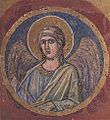Old St. Peter's Basilica
| St. Peter's Basilica | ||
|---|---|---|
Basilica Sancti Petri ( Style Early Christian | | |
| Groundbreaking | Between 326 and 333 | |
| Completed | c. 360 | |
| Demolished | c. 1505 | |
| Administration | ||
| Diocese | Diocese of Rome | |
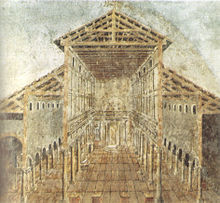
Old St. Peter's Basilica was the church buildings that stood, from the 4th to 16th centuries, where
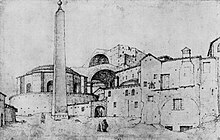
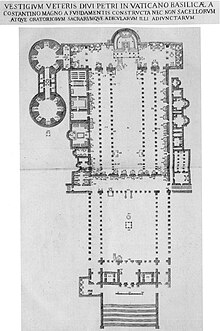

History
Construction began by orders of the Roman Emperor
By the 15th century, the church was falling into ruin. Discussions on repairing parts of the structure commenced upon the pope's return from Avignon. Two people involved in this reconstruction were Leon Battista Alberti and Bernardo Rossellino, who improved the apse and partially added a multi-story benediction loggia to the atrium façade, on which construction continued intermittently until the new basilica was begun. Alberti pronounced the basilica a structural abomination:
I have noticed in the basilica of St. Peter's in Rome a crass feature: an extremely long and high wall has been constructed over a continuous series of openings, with no curves to give it strength, and no
buttresses to lend it support... The whole stretch of wall has been pierced by too many openings and built too high... As a result, the continual force of the wind has already displaced the wall more than six feet (1.8 m) from the vertical; I have no doubt that eventually some... slight movement will make it collapse...[8]
At first, Pope Julius II had every intention of preserving the old building, but his attention soon turned toward tearing it down and building a new structure. Many people of the time[who?] were shocked by the proposal, as the building represented papal continuity going back to Saint Peter. The original altar was to be preserved in the new structure that housed it.
Design

The design was a typical basilica form
Constantine took great pains to build the basilica on the site he and
The church was capable of housing from 3,000 to 4,000 worshipers at one time. It consisted of five aisles, a wide central
The altar of Old St. Peter's Basilica used several
Mosaics


The great
The nave ended with an arch, which held a mosaic of Constantine and Saint Peter, who presented a model of the church to Christ. On the walls, each having 11 windows, were
The fragment of an 8th-century mosaic, the Epiphany, is one of the very rare remaining bits of the medieval decoration of Old St. Peter's Basilica. The precious fragment is kept in the sacristy of Santa Maria in Cosmedin. It proves the high artistic quality of the destroyed mosaics. Another one, a standing madonna, is on a side altar in the Basilica of San Marco in Florence.
-
Navicella mosaic – fragment in Boville Ernica
-
Navicella mosaic – fragment in Vatican
-
Mosaic of the Adoration of the Magi, today in Santa Maria in Cosmedin
-
Mater misericordiae, today in San Marco in Florence
-
Mosaic, today in the Museo Barracco
-
Two pairs of the original Solomonic columns now support curved pediments to formporticoeson the piers of St. Peter's
-
Solomonic Column
Tombs
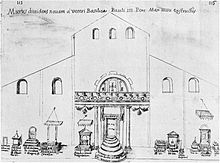
Since the crucifixion and burial of Saint Peter in 64 AD, the spot was thought to be the location of the tomb of Saint Peter, where there stood a small shrine. With its increasing prestige, the church became richly decorated with statues, furnishings and elaborate chandeliers, and side tombs and altars were continuously added.[1]
The structure was filled with tombs and bodies of saints and popes. Bones continued to be found in construction as late as February 1544.
The majority of these tombs were destroyed during the 16th and 17th centuries' demolition of Old St. Peter's Basilica (save one which was destroyed during the
The only papal tombs to survive the demolition and be properly reconstructed in the present St Peter's are the two from the 1490s by Antonio del Pollaiuolo, of Pope Innocent VIII and Pope Sixtus IV. These were well-regarded and innovative works, with bronze effigies by a major Florentine sculptor.[16]
Along with the repeated translations from the ancient Catacombs of Rome and two 14th century fires in the Archbasilica of Saint John Lateran, the rebuilding of St. Peter's is responsible for the destruction of approximately half of all papal tombs. As a result, Donato Bramante, the chief architect of modern St. Peter's Basilica, has been remembered as Maestro Ruinante.[17]
Stefaneschi Triptych


The Stefaneschi Altarpiece is a
for one of the altars of Old St. Peter's Basilica in Rome.It is a rare example in Giotto's work of a documented commission, and includes Giotto's signature, although the date, like most dates for Giotto, is disputed, and many scholars feel the artist's workshop was responsible for its execution.
See also
- List of Greco-Roman roofs
- Index of Vatican City-related articles
Notes
- ^ a b c d e Boorsch, Suzanne (Winter 1982–1983). "The Building of the Vatican: The Papacy and Architecture". The Metropolitan Museum of Art Bulletin. 40 (3): 4–8.
- ^ Reardon, 2004. p. 274
- ^ Marian Moffett, Michael Fazio, Lawrence Wodehouse, A World History of Architecture, 2nd edition 2008, pp. 135
- ^ Davis, Raymond, The Lives of the Ninth-Century Popes (Liber pontificalis), (Liverpool University Press, 1995), 96.
- ISBN 9780520021815. Retrieved 6 April 2019.
it was not at this time unusual for Muslims to desecrate Christian Churches for the sake of desecrating them, excavation has revealed that the tomb of the apostle was wantonly smashed
- ^ Barbara Kreutz (1996). Before the Normans: Southern Italy in the Ninth and Tenth Centuries. University of Pennsylvania Press pp. 25–28.
- ^ Rosemary Guiley, The Encyclopedia of Saints, (InfoBase Publishing, 2001), 208.
- ISBN 0-521-64096-2.
- ISBN 0-933691-09-2.
- ISBN 0-15-505090-7.
- ISBN 0-15-503769-2.
- ^ ISBN 0-15-503769-2.
- ISBN 0-15-505090-7.
- ^ "Old Saint Peter's Basilica." Encyclopædia Britannica. 2006.
- ISBN 0-900658-15-0.
- ^ Ettlinger, L. D. "Pollaiuolo's Tomb of Pope Sixtus IV", Journal of the Warburg and Courtauld Institutes, vol. 16, no. 3/4, 1953, pp. 239–74, JSTOR
- ^ Patetta, Federico (1943). La figura del Bramante nel "Simia" d'Andrea Guarna (in Italian). Roma: Accademia Nazionale dei Lincei.
- ^ His name is also often found as Jacopo Caetani degli Stefaneschi.
- ^ Gardner, 57–58, gives the documentation from the obituary book of St. Peter's. Most scholars date the altarpiece to c. 1320; Gardner dates it to c. 1300; Anne Mueller von den Haegen dates it to c. 1313; Kessler dates it to between 1313 and 1320.
- ^ Kempers and De Blaauw, 88–89; Kessler, 91–92.
Further reading
- The Vatican: spirit and art of Christian Rome. New York: The Metropolitan Museum of Art. 1982. ISBN 0870993488. (pp. 51–61)
- ISBN 9780870991790
External links
- The Constantinian Basilica Article by Jose Ruysschaert
- The Tomb of St Peter, book by Margherita Guarducci


